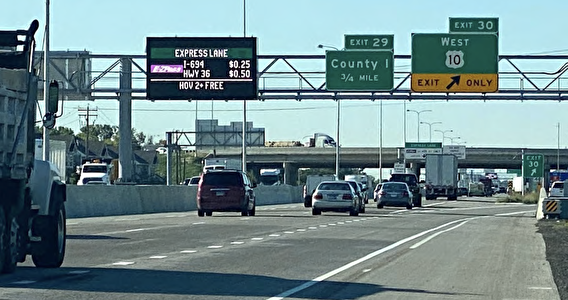
Managed lanes, such as Minnesota’s E-ZPass, are often perceived as being inequitable—but is that really the case? A study by U of M researchers shows that users of Minnesota’s E-ZPass lanes are slightly more racially diverse than the larger population and that there is little income difference between E-ZPass users and the general population of transportation users. E-ZPass account holders, however, have higher incomes, and a lower percentage of people with disabilities use the lanes.
These are some of the findings of a U of M study that analyzed managed-lane equity and identified ways for agencies to measure and enhance it. Managed lanes give transportation agencies a strategy for reducing congestion and improving travel times along urban highways. For example, E-ZPass lanes are available for free to carpoolers and transit riders (about 80 percent of all users) during high-traffic times, while people driving alone pay a fee. Opponents, however, have doubted the lanes’ fairness, calling them “Lexus lanes” for wealthier drivers.
E-ZPass lanes are in operation on I-394, I-35W, and I-35E in the Twin Cities metro, and several more managed lane projects are in the planning stages. As such lanes become more widespread, agencies want to ensure they are equally accessible and used by all communities and populations. MnDOT and the Minnesota Local Road Research Board (LRRB) enlisted the help of U of M researchers to investigate.
The work was led by Adeel Lari, now retired from the Institute for Urban and Regional Infrastructure Finance (IURIF) in the Humphrey School of Public Affairs. Co-investigators were Camila Fonseca-Sarmiento, IURIF director of fiscal research , and Frank Douma, IURIF director of state and local policy and outreach.
The researchers began by comparing the demographics of E-ZPass lane users with those of the general population. Next, they explored methods for measuring and comparing the equity impacts of project alternatives (a new managed lane vs. spot mobility improvements, for example) on different demographic subgroups. They identified 27 measures that had been used in previous projects, then winnowed the list to 9 after assessing each measure’s feasibility.
“We analyzed and identified metrics that are all feasible to use with existing tools and that can be put into practice immediately,” Fonseca-Sarmiento says. “The metrics will provide meaningful information to the alternatives-analysis process—and help elevate community voices.”
The metrics will be useful beyond their application to managed lanes, she adds, as the general concepts could be used for other transportation services and highway projects as well.
Researchers then applied the new metrics to the alternatives analysis MnDOT performed for a previous managed-lane project ( I-35W in the north metro) to illustrate how the metrics could be used in future projects. Finally, they explored ways to mitigate the burden of lanes—and share the benefits—for the residents who live near them.
Currently, equity impacts are not specifically required in environmental assessments or impact statements. Recent federal and state legislative and executive actions, however, support and may require agencies to consider equity across populations in project planning.
“These results will play a significant role in enabling MnDOT and its partners to further enhance equity on the E-ZPass managed lane system, and [may aid] all the state’s transportation agencies in the overall planning process,” says Bradley Larsen, E-ZPass policy and planning program director with MnDOT Metro District’s Office of Planning, Program Management and Transit.
MnDOT is now using the study results to consider a discount program for low-income E-ZPass users and incentive programs for public transportation. In addition, it may consider developing a program to distribute the benefits of the E-ZPass program more equitably. Suburban commuters—especially those who travel long distances—gain more benefit from the lanes than inner-ring residents. A program could reduce this geographic mismatch by investing lane revenues for targeted improvements (such as sound walls) in communities next to lane corridors. “This research will help us move forward on these efforts,” Larsen says.
Others on the research team were Paul Morris of SRF Consulting, who led the alternatives analysis; Daniel Murphy, a Humphrey School graduate research assistant; and IURIF founder and advisor Zhirong (Jerry) Zhao.
—Megan Tsai, contributing writer


